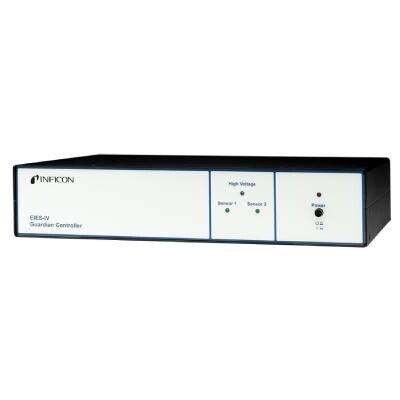Simultaneous Deposition of Up to Eight Materials - Ideal for CIGS Thin Films
Guardian can control deposition rates from 0.1 to 10,000 Å/s. It operates one or two sensors, up to 8 optical inputs and controls up to 8 deposition sources, enabling co-deposition of up to 8 materials.
The Guardian Co-deposition System is based on Electron Impact Emission Spectroscopy (EIES). Using EIES, the material being deposited is excited by a thermionic emitter, which results in creation of photons. The light created passes through an optical filter to a photomultiplier tube (PMT) detector, which measures the intensity of emission of the passed wavelength. The INFICON Guardian Controller then generates a signal to control the source for that material. Additional detectors, with appropriate optical filters, are used for multiple materials.
A complete Guardian system consists of at least one sensor, one PMT detector, an optical filter, a Guardian controller unit, and a PC (user-supplied) with Guardian software. EIES is generally used to control deposition of multiple materials, so most EIES systems include additional sensors, detectors, optical components such as beam splitters, and QCMs for calibration or controlling deposition rate for some materials. More information on typical systems can be found in the Guardian Configuration Guide in the Downloads tab below.
To Configure a Guardian Co-deposition System, Consider the Following
What are the primary and secondary emission wavelengths for your deposition materials?
If different materials have peaks too close to each other, you may need to monitor a secondary wavelength, which has lower signal strength.
During the deposition process, what background gases are present in your vacuum chamber and what are the emission wavelengths for those gases?
If emissions from background gases interfere with the deposition materials, a gas compensating sensor is recommended.
EIES is most effective with the uniquely defined spectra of atomic species. Molecular species that generate unstable or broad emission spectra cannot be measured accurately. EIES is not recommended for organic materials. These, and other factors, determine the optimum EIES system configuration for each specific application.
FEATURES
- Monitor and control simultaneous deposition of up to 8 materials
- Deposition rates from 0.1 to 10,000 Å/s
- Integrated EIES and QCM thin film process control
- 12 relay outputs and 12 digital inputs
- Windows-based software for setup and operation
- Compatible with INFICON Sentinel® sensors
